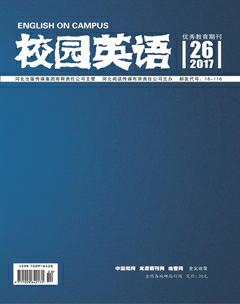On the Translation of Pun in Literary Works
肖扬
【Abstract】To pun is to use a word or words to get two meanings, literal meaning and connotation meaning to achieve humorous or sarcastic sense. It is a widely-used figure of speech in both English language and Chinese language, especially in the literary works. The use of pun makes literary works not only vivid but also humorous and sarcastic. In order to better represent the artistic beauty of pun in literary works, the author will explore the translation methods of pun in this paper.
【Key words】pun; classification; translatability; translation
Ⅰ. Introduction
Both English pun and Chinese pun are based on the pronunciation and semantic meaning of words and sentences. Nowadays, puns are no longer considered to be the superior use of language. They spring to the eye or ear from formal occasions to the daily usage, from literature, such as novels, poems, plays, couplets, cross-talks, to practical writings such as news headlines and advertisements. Since they are so widely used and they are the essence of the language and culture, we need to spare no effort to reproduce the artistic beauty of them in the target language.
In this paper, the author will focus on the translation of pun in literary works. First, the author will introduce the definitions of both English pun and Chinese pun, and then by analyzing the examples and comparing several translation versions, he will give some useful and effective methods to tackle the problem.
Ⅱ. Definitions and Classifications of Pun
2.1 English Definition
In Websters New World Dictionary pun is defined as “the humorous use of a word or words which are formed or sounded alike but have different meanings, in such a way as to play on two or more of the possible applications; a play on words.”
2.2 Chinese Definition
In Chinese Rhetoric Dictionary pun is to use a word or a sentence with the same pronunciation or polysemy to achieve both the literal and figurative meanings and focus on the figurative meaning.
From both Chinese definition and English definition, we can find that puns are to use a word or words to get double meanings. And this similarity makes the translation of pun possible.
Ⅲ. Translation between English and Chinese Pun
Peter Newmark has offered some methods to translate puns, but in this paper the author will focus on the translation of pun in literary works. In my opinion, there are 7 methods in all.
3.1 Using pun to translate punendprint
This is the best way to translate pun because in this way we not only can express the full meaning but also can successfully keep the punny sense of the original text. But it is based on the fact that there do exist some equivalent expressions between English language and Chinese language. After translating pun in this way the target language is made pleasant or even amusing,
3.2 Preserving the surface meaning
In some cases, it is difficult or improper to keep the double meanings of pun in the target language. At this time we may need to decide which meaning, surface or underlying meaning, should be kept. This depends on the fluency of the original text or the pragmatic usage.
3.3 Preserving the underlying meaning
Because pun is to use a word or words to express two meanings, surface meaning and underlying meaning and the underlying meaning is usually the meaning the author wants to express. So when translating pun, preserving the underlying meaning can let the reader know the author true purpose.
3.4 Preserving both the surface meaning and the underlying meaning
Sometimes in the target language, it is really hard to find the corresponding word that happens to bear the same double meanings in the source language. So usually puns are represented literally by two words in target language.
3.5 Using paronym to compensate pun
Sometimes in target language itself we may happen to find paronym to reproduce the pun made in source language.
3.6 Using shifting
Shifting is to shift the pun to other part of the sentence or paragraph. It is used when the target language can not reproduce the pun in the source language.
3.7 Using substitute
Since in the target language it is very difficult to find the equivalent words or expression which can express the double meanings in the source language, we may-try to use substitute to translate puns.
Ⅳ. Conclusion
By now, we can reach the conclusion that puns can be well translated if we use suitable translation methods according to different context. But pun is to some extent translatable, because pun is deep-rooted in culture and language and there are differences in Chinese and English languages and cultures, punny effect and humorous sense will be lost in the process of translation. So we have to try our best to find out suitable translating methods in order to use target language to represent the artistic beauty of pun by analyzing the context carefully.
References:
[1]Peter Newmark.A Textbook of Translation.Shanghai Foreign Language Education Press.2001.endprint

